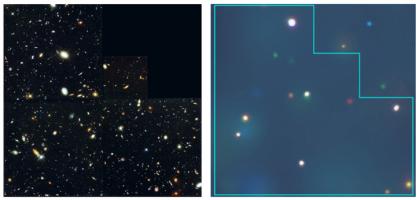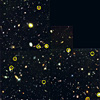Chandra Deep Field-North:
 Credit: NASA/PSU/G.Garmire, N.Brandt, et al.
Credit: NASA/PSU/G.Garmire, N.Brandt, et al.
This side-by-side presentation of
the Hubble Deep Field-North (left) and the Chandra Deep
Field-North (right) clearly demonstrates the importance
of looking at the universe in both the optical and
X-ray regimes. Twelve X-ray sources are detected
in the HDF-N. The false colors represent the "X-ray color"
of the objects. Objects that appear more red are
cooler in the X-ray band, while objects that appear
more blue are hotter in the X-ray band. About half of
the sources show strong evidence that the X-rays are
due to accretion onto supermassive black holes. The
other sources have much lower luminosities, and in
several cases are fairly nearby. In these galaxies, the
Chandra X-ray detection is most likely the summed
emission from a handful (or even one) bright sources
within the galaxy, such as stellar-size black holes in
binary star systems, the hot gas within the galaxy, or
the remnants of supernova explosions. Chandra is thus
now peering far enough into the universe to detect the
type of X-ray emission that one finds in "normal"
galaxies such as the Milky Way. This allows us to look
back several billion years to see what our own galaxy
and neighborhood (the Local Group) might have been like
at earlier times.
| Fast Facts for Chandra Deep Field-North: |
| Credit |
NASA/PSU/G.Garmire, N.Brandt, et al. |
| Scale |
Image is
2.5 arcmin across. |
| Category |
Cosmology/Deep Fields/X-ray Background, Black Holes
|
| Coordinates (J2000) |
RA 12h 36m 45.70s | Dec +62° 13´ 58.00" |
| Constellation |
Ursa Major |
| Observation Dates |
November 1999 - February 2001 |
| Observation Time |
139 hours |
| Obs. IDs |
580, 966, 967, 957, 1671, 2386, 2344 |
| Color Code |
Colors indicate temperature or X-ray hardness, but brighter sources are more intense. |
| Instrument |
ACIS |
| Release Date |
March 13, 2001 |
|





